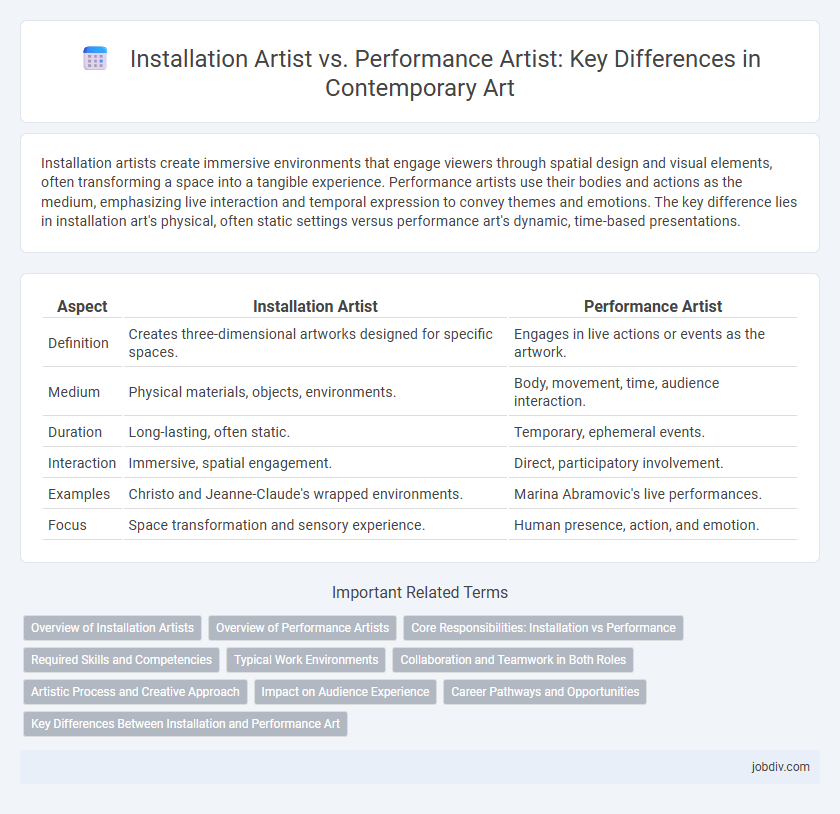Installation artists create immersive environments that engage viewers through spatial design and visual elements, often transforming a space into a tangible experience. Performance artists use their bodies and actions as the medium, emphasizing live interaction and temporal expression to convey themes and emotions. The key difference lies in installation art's physical, often static settings versus performance art's dynamic, time-based presentations.
Table of Comparison
| Aspect | Installation Artist | Performance Artist |
|---|---|---|
| Definition | Creates three-dimensional artworks designed for specific spaces. | Engages in live actions or events as the artwork. |
| Medium | Physical materials, objects, environments. | Body, movement, time, audience interaction. |
| Duration | Long-lasting, often static. | Temporary, ephemeral events. |
| Interaction | Immersive, spatial engagement. | Direct, participatory involvement. |
| Examples | Christo and Jeanne-Claude's wrapped environments. | Marina Abramovic's live performances. |
| Focus | Space transformation and sensory experience. | Human presence, action, and emotion. |
Overview of Installation Artists
Installation artists create immersive, three-dimensional environments that transform spaces and invite viewers to experience art physically and emotionally. Their work often incorporates a variety of materials, including natural elements, found objects, and multimedia components, emphasizing spatial relationships and sensory engagement. Pioneers like Yayoi Kusama and Olafur Eliasson exemplify how installation art challenges traditional gallery settings by fostering interaction and redefining the boundaries between art and viewer.
Overview of Performance Artists
Performance artists create live, time-based works that combine visual art with elements of theater, dance, and music, emphasizing the artist's body as the primary medium. Their work often challenges traditional art forms by engaging directly with the audience and site-specific contexts, fostering immersive and interactive experiences. Key figures in performance art include Marina Abramovic, Yoko Ono, and Laurie Anderson, whose practices highlight endurance, emotion, and social commentary.
Core Responsibilities: Installation vs Performance
Installation artists create immersive, three-dimensional environments that engage viewers through spatial manipulation and material experimentation, emphasizing visual and sensory experiences. Performance artists focus on live actions or events where the artist's body or presence becomes the medium, exploring themes of time, identity, and interaction with the audience. Both disciplines prioritize experiential engagement but differ in execution: installations are static yet interactive spaces, while performances are dynamic, temporal expressions.
Required Skills and Competencies
Installation artists require proficiency in spatial awareness, material manipulation, and conceptual design to create immersive environments, often integrating multimedia elements and architectural knowledge. Performance artists must possess strong skills in body movement, emotional expression, improvisation, and audience engagement to deliver live, often ephemeral experiences. Both disciplines demand creativity and technical expertise, but installation art emphasizes physical construction while performance art prioritizes dynamic interaction and temporal presence.
Typical Work Environments
Installation artists typically create immersive, site-specific environments in galleries, museums, or outdoor spaces, manipulating physical materials to transform the viewer's spatial experience. Performance artists often work in theaters, public spaces, or unconventional venues where live interaction and temporal expression drive the artistic process. Both disciplines require adaptable settings that support conceptual intentions and audience engagement through spatial and temporal dynamics.
Collaboration and Teamwork in Both Roles
Installation artists often collaborate with architects, engineers, and fabricators to create immersive environments that engage multiple senses, requiring precise coordination and technical teamwork. Performance artists rely on collaboration with musicians, choreographers, and fellow performers to develop dynamic live presentations that emphasize timing, interaction, and spontaneity. Both roles demand strong communication skills and the ability to adapt creatively within a team to successfully realize complex artistic visions.
Artistic Process and Creative Approach
Installation artists engage with physical space to construct immersive environments, emphasizing spatial relationships and sensory experiences through materials and architecture. Performance artists prioritize live actions and bodily expressions, using time, movement, and audience interaction as integral components of their creative process. Both practices challenge traditional art boundaries but differ in their focus on materiality versus temporality in artistic expression.
Impact on Audience Experience
Installation artists create immersive environments that engage multiple senses, allowing audiences to explore space and meaning physically, fostering personal interpretation and prolonged interaction. Performance artists, by contrast, offer dynamic, time-based experiences that emphasize human presence and emotional connection, often evoking immediate, visceral responses. Both forms transform audience engagement, with installations shaping perception through spatial immersion and performances delivering direct, impactful narratives.
Career Pathways and Opportunities
Installation artists often pursue careers involving gallery exhibitions, museum commissions, and public art projects that emphasize spatial design and multimedia integration. Performance artists typically build careers through live events, theater collaborations, and festivals, focusing on ephemeral, time-based artistic expressions. Both pathways offer opportunities in education, residencies, and interdisciplinary collaborations, but installation art leans more toward physical environment engagement while performance art centers on live audience interaction.
Key Differences Between Installation and Performance Art
Installation artists create immersive, three-dimensional environments that transform a space through physical materials, engaging viewers visually and spatially. Performance artists emphasize live actions and time-based experiences, often incorporating the artist's body and interaction with the audience as a central element. Key differences include the static versus ephemeral nature of the work, the spatial engagement in installation art, and the temporal, often unpredictable, aspects inherent in performance art.
Installation Artist vs Performance Artist Infographic

 jobdiv.com
jobdiv.com